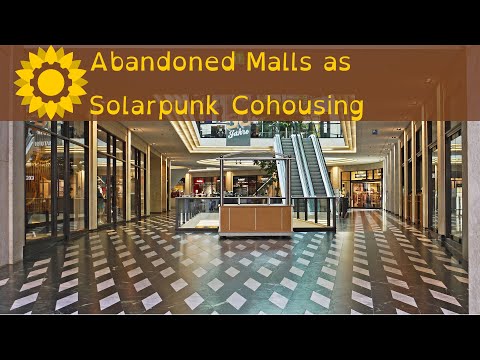Victor Gruen who effectively created the modern shopping mall, originally envisioned them as the center of a full-fledged community including apartments, schools, medical, parks, etc. Because Southdale Mall (1956) was commercially successful, the developers never bothered to implement the rest of his design and everything since has only inherited the commercial aspects. Since they acted as a de facto third place, the shortcomings never became apparent – but with the rise of anti-loitering ordinances, the deaths of the major anchors, and the shift to online shopping, malls no longer had anything to tie them to the community.
Marc Augé even called them “non-places”, spaces without any sense of identity and belonging. Everything in there is just optimized for consumption and commerce. Malls are very specialised as you described, rendering them obsolete as soon as circumstances shift a little. Just speaks die the short-sightedness of their developers and the municipality that thought of them as a good idea.
I love this! There’s a mall in my area that’s on its last legs, and it has this huge sprawling parking lot that’s never used. Also, unlike most malls, this one is connected to other parts of the community via a trail system. The unused space has so much potential to turn into a sprawling community hub, it just needs the chance to do so.
I wonder what the best methods of reclaiming this kind of space actually are. The video mentioned getting people to fundraise/buy the property together, but I wonder how many people you would need to raise that kind of money. I also wonder if any zoning laws might threaten these types of communities.
You can also make the case that not only is a dead mall a money pit, but parking lots are also a money pit! Having people living and doing business in that space generates much more decent property tax revenue, in addition to revitalizing the vibe of the neighborhood.
Honestly, it boils down to the municipal government backing these efforts. If they’re onboard, they can send out RFPs to contractors, and reach out to investors to get the ball rolling.
You should look at the Eden project. they did something kind of similar. They had a shitty old kaolonite mine, and turned it into biodomes in 2001. Since then it’s generated 1.1 B pounds (the currency) of revenue. It wasn’t near anything either, which piggy backs onto my ‘if you build it, they will come’ comment below.
I just want to see something like FEAST from the Spider-Man games built into these malls
Nice to see another FEAST appreciator out there!
This is a cool idea.
I think we need to take it one step further and have these dying malls turned into affordable housing for homeless people.
While you don’t want to start a slum, or shuffle homeless people to be ‘less visible’ you could have these malls have services to support them. For instance, addictions counseling.
Something as simple as a safe place to sleep, and access to regular food and water can really help people get back on their feet.
These malls are often hard to reach by anything other than a car, thus if you don’t have a thriving community within its not going to be very attractive even for homeless people that usually still try to find jobs or otherwise partake in social life.
I could imagine old malls being used as elderly care homes though.
I think if you convert the parking lot into farmers markets and gardens and parks, and swap meets, they people might not need to leave much.
That’s another good use.
While I read the text in the link that mentions the access issue, I don’t agree. My city is notoriously inaccessible to anything but cars, but this doesn’t stop homeless from congregating wherever is suitable to them (often green spaces). I think a ‘if you build it they will come’ approach would probably work.
Looks like it could be a fun place to live, though I’m concerned about heating and cooling. Where I am, malls cannot survive without massive airconditioning.
Yeah, I’d imagine a building would need some modifications to work well. Though I think that large-space HVAC is a problem that’s already been solved in other contexts, such as large office and academic buildings. Some retrofitting or other architectural adjustments might still be needed, of course. And the plans should definitely be double-checked in light of climate change making current conditions different from how they were whenever each particular mall was built, probably decades ago.
Cool. Kind of like Dawn of the Dead.
Like the article says, I’ve heard a lot about this idea but it seems people keep pointing to that one mall in Rhode Island that got redeveloped as mini-apartments. I really wish this got more traction and implementation.
And it’s not like local people don’t want this. By and large, everyone agrees that dead malls are an eyesore and a waste of space and energy and money. Some people already take it upon their own initiative to try to make something of this, though currently, due to things like zoning laws making them hard to redevelop formally, the people who do take such initiative tend to be those who are left with no other choice in life – i.e. the homeless, who find shelter there. Some people see homeless people with unkempt hair and unwashed clothing (and possibly mental disorders in addition) and get weirded out, but they really ought to adjust their thinking – these weird-looking people are the pioneers, frankly, making use of a space that everyone else has just been leaving unused, for one reason or another. They’re the ones going to spaces the rest of us won’t go to, and making something of them. They’re amazing and admirable, frankly.
Anyhow, regardless of people’s opinions on the homeless, I think there’s broad consensus that something does need to be done about dead and dying malls, and frankly there’s also some quite reasonable concerns about building safety for poorly maintained infrastructure anyway. And I don’t think there’s anyone who doesn’t complain about the cost of housing. So what we really need is to get people together to agree to solve this problem by providing more financially and environmentally sustainable solutions – and mixed-use space for housing and business – which would actually complement each other, one providing services and goods and the other providing a customer base – is an excellent option for redevelopment, assuming the original building shell is still in decent condition.
Other larger abandoned buildings in cities here in Europe are often squatted by an active community and turned into alternative art and community centres. In some cases and usually after much struggle to not get evicted these places have also been legalized into quite nice places over the years. However if think the typical mall buildings with their lack of windows and other such problems are unlikely to be attractive for this.








